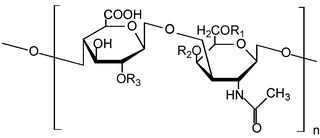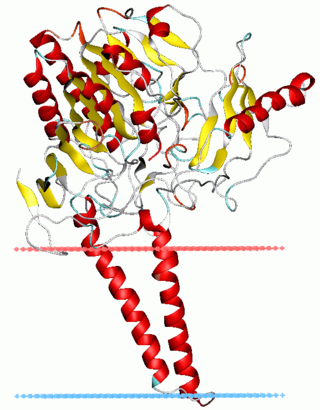Related Research Articles

Glycosaminoglycans (GAGs) or mucopolysaccharides are long, linear polysaccharides consisting of repeating disaccharide units. The repeating two-sugar unit consists of a uronic sugar and an amino sugar, except in the case of the sulfated glycosaminoglycan keratan, where, in place of the uronic sugar there is a galactose unit. GAGs are found in vertebrates, invertebrates and bacteria. Because GAGs are highly polar molecules and attract water; the body uses them as lubricants or shock absorbers.

N-Acetylglucosamine (GlcNAc) is an amide derivative of the monosaccharide glucose. It is a secondary amide between glucosamine and acetic acid. It is significant in several biological systems.
The terms glycans and polysaccharides are defined by IUPAC as synonyms meaning "compounds consisting of a large number of monosaccharides linked glycosidically". However, in practice the term glycan may also be used to refer to the carbohydrate portion of a glycoconjugate, such as a glycoprotein, glycolipid, or a proteoglycan, even if the carbohydrate is only an oligosaccharide. Glycans usually consist solely of O-glycosidic linkages of monosaccharides. For example, cellulose is a glycan composed of β-1,4-linked D-glucose, and chitin is a glycan composed of β-1,4-linked N-acetyl-D-glucosamine. Glycans can be homo- or heteropolymers of monosaccharide residues, and can be linear or branched.

Keratan sulfate (KS), also called keratosulfate, is any of several sulfated glycosaminoglycans that have been found especially in the cornea, cartilage, and bone. It is also synthesized in the central nervous system where it participates both in development and in the glial scar formation following an injury. Keratan sulfates are large, highly hydrated molecules which in joints can act as a cushion to absorb mechanical shock.

Sulfatases EC 3.1.6.- are enzymes of the esterase class that catalyze the hydrolysis of sulfate esters. These may be found on a range of substrates, including steroids, carbohydrates and proteins. Sulfate esters may be formed from various alcohols and amines. In the latter case the resultant N-sulfates can also be termed sulfamates.

Arylsulfatase B is an enzyme associated with mucopolysaccharidosis VI.
N-acetylgalactosamine-4-sulfatase is an enzyme with systematic name N-acetyl-D-galactosamine-4-sulfate 4-sulfohydrolase. It catalyses the following reaction:

Aggrecan (ACAN), also known as cartilage-specific proteoglycan core protein (CSPCP) or chondroitin sulfate proteoglycan 1, is a protein that in humans is encoded by the ACAN gene. This gene is a member of the lectican (chondroitin sulfate proteoglycan) family. The encoded protein is an integral part of the extracellular matrix in cartilagenous tissue and it withstands compression in cartilage.

N-acetylgalactosamine-6-sulfatase is an enzyme that, in humans, is encoded by the GALNS gene.

N-acetylglucosamine-6-sulfatase (EC 3.1.6.14, glucosamine (N-acetyl)-6-sulfatase, systematic name N-acetyl-D-glucosamine-6-sulfate 6-sulfohydrolase) is an enzyme that in humans is encoded by the GNS gene. It is deficient in Sanfilippo Syndrome type IIId. It catalyses the hydrolysis of the 6-sulfate groups of the N-acetyl-D-glucosamine 6-sulfate units of heparan sulfate and keratan sulfate
The enzyme chondro-4-sulfatase (EC 3.1.6.9) catalyzes the reaction
In enzymology, a glycoprotein-N-acetylgalactosamine 3-beta-galactosyltransferase is an enzyme that catalyzes the chemical reaction

Carbohydrate sulfotransferase 6 is an enzyme that in humans is encoded by the CHST6 gene.

Carbohydrate sulfotransferase 1 is an enzyme that in humans is encoded by the CHST1 gene.

Sialidase-1, is a mammalian lysosomal neuraminidase enzyme which in humans is encoded by the NEU1 gene.

Carbohydrate sulfotransferases are sulfotransferase enzymes that transfer sulfate to carbohydrate groups in glycoproteins and glycolipids. Carbohydrates are used by cells for a wide range of functions from structural purposes to extracellular communication. Carbohydrates are suitable for such a wide variety of functions due to the diversity in structure generated from monosaccharide composition, glycosidic linkage positions, chain branching, and covalent modification. Possible covalent modifications include acetylation, methylation, phosphorylation, and sulfation. Sulfation, performed by carbohydrate sulfotransferases, generates carbohydrate sulfate esters. These sulfate esters are only located extracellularly, whether through excretion into the extracellular matrix (ECM) or by presentation on the cell surface. As extracellular compounds, sulfated carbohydrates are mediators of intercellular communication, cellular adhesion, and ECM maintenance.
Glucuronylgalactosylproteoglycan 4-beta-N-acetylgalactosaminyltransferase is an enzyme with systematic name UDP-N-acetyl-D-galactosamine:D-glucuronyl-(1->3)-beta-D-galactosyl-proteoglycan 4-beta-N-acetylgalactosaminyltransferase. This enzyme catalyses the following chemical reaction
Glucuronosyl-N-acetylgalactosaminyl-proteoglycan 4-beta-N-acetylgalactosaminyltransferase is an enzyme with systematic name UDP-N-acetyl-D-galactosamine:beta-D-glucuronosyl-(1->3)-N-acetyl-beta-D-galactosaminyl-proteoglycan 4-beta-N-acetylgalactosaminyltransferase. This enzyme catalyses the following chemical reaction
N-acetylgalactosamine 4-sulfate 6-O-sulfotransferase is an enzyme with systematic name 3'-phosphoadenylyl-sulfate:(dermatan)-4-O-sulfo-N-acetyl-D-galactosamine 6-O-sulfotransferase. This enzyme catalyses the following chemical reaction
Dermatan 4-sulfotransferase is an enzyme with systematic name 3'-phospho-5'-adenylyl sulfate:(dermatan)-N-acetyl-D-galactosamine 4-sulfotransferase. This enzyme catalyses the following chemical reaction
References
- ↑ Epstein EH, Leventhal ME (1981). "Steroid sulfatase of human leukocytes and epidermis and the diagnosis of recessive X-linked ichthyosis". J. Clin. Invest. 67 (5): 1257–62. doi:10.1172/JCI110153. PMC 370691 . PMID 6939689.
- ↑ Sorensen SH, Noren O, Sjostrom H, Danielsen EM (1982). "Amphiphilic pig intestinal microvillus maltase/glucoamylase Structure and specificity". Eur. J. Biochem. 126 (3): 559–68. doi:10.1111/j.1432-1033.1982.tb06817.x. PMID 6814909.
- ↑ Lim CT, Horwitz AL (1981). "Purification and properties of human N-acetylgalactosamine-6-sulfate sulfatase". Biochim. Biophys. Acta. 657 (2): 344–55. doi:10.1016/0005-2744(81)90320-x. PMID 7213753.
- ↑ Glossl J, Kresse H (1982). "Impaired degradation of keratan sulphate by Morquio A fibroblasts". Biochem. J. 203 (1): 335–8. PMC 1158229 . PMID 6213226.
- ↑ Yutaka T, Okada S, Kato T, Inui K, Yabuuhi H (1982). "Galactose 6-sulfate sulfatase activity in Morquio syndrome". Clin. Chim. Acta. 122 (2): 169–80. doi:10.1016/0009-8981(82)90276-5. PMID 6809361.